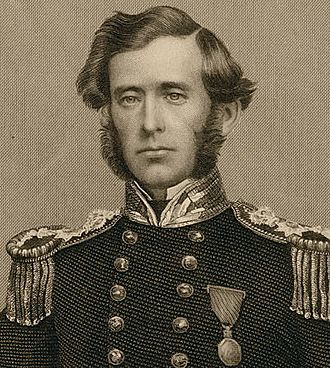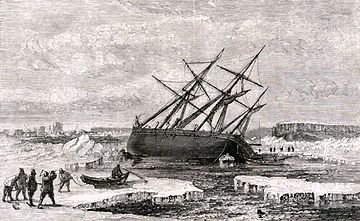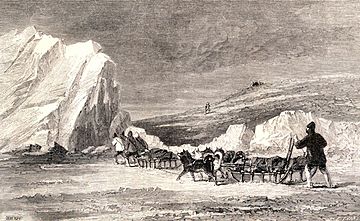Leopold McClintock facts for kids
Quick facts for kids
Sir
Leopold McClintock
|
|
|---|---|

McClintock c. 1860
|
|
| North America and West Indies Station | |
| Commander-in-Chief 27 November 1879 – 7 November 1882 |
|
| Preceded by | Sir Edward Inglefield |
| Succeeded by | Sir John Commerell |
| Jamaica Division | |
| Commodore 6 September 1865 – 21 February 1868 |
|
| Preceded by | Sir Algernon de Horsey |
| Succeeded by | Sir Augustus Phillimore |
| Personal details | |
| Born |
Francis Leopold McClintock
8 July 1819 Dundalk, County Louth, Ireland |
| Died | 17 November 1907 (aged 88) Kensington, London, England |
| Resting place | Hanwell Cemetery |
| Spouse |
Annette Dunlop
(m. 1870) |
| Children | John William McClintock |
| Awards |
|
| Military service | |
| Allegiance | |
| Branch | |
| Service years | 1835–1884 |
| Rank | Admiral |
| Expeditions | McClintock Arctic expedition |
Sir Francis Leopold McClintock (born July 8, 1819 – died November 17, 1907) was an Irish explorer. He served in the British Royal Navy. He is famous for his discoveries in the Canadian Arctic Archipelago.
McClintock helped confirm what explorer John Rae had reported. Rae had heard from the Inuit people about what happened to the lost Franklin's lost expedition. This was a Royal Navy journey led by Sir John Franklin in 1845. They were trying to be the first to sail through the Northwest Passage.
Rae's report was not believed by many at first. He was not given credit for finding out the expedition's fate. But Rae's information eventually helped McClintock search in the right area. McClintock also caused some debate. He claimed that Franklin had basically discovered the Northwest Passage before he died. However, Franklin had not. Rae, by finding Rae Strait, had actually discovered the true ice-free way through North America's Arctic islands.
Contents
Early Life
McClintock was born on July 8, 1819. He was one of 14 children. His father, Henry McClintock, worked as a customs collector in Dundalk, County Louth, Ireland. His mother was Elizabeth Melesina Fleury. Leopold was the second oldest son. His older brother died when he was a baby.
His family had good connections. McClintock's uncle, John McClintock, was a Member of Parliament for County Louth. He owned a large house called Drumcar House.
Arctic Exploration
In 1835, McClintock joined the Royal Navy as a volunteer. In 1843, he passed his exams and became an officer (a lieutenant). He then joined the steamship "Gorgon". This ship got stuck near Montevideo, but the crew managed to save it. This showed how skilled the captain and officers were. Until 1847, McClintock mostly served on the American coasts.
McClintock joined several search missions for Sir John Franklin between 1848 and 1859. He became very good at traveling by pulling sleds himself. This method was the main way to travel over icy land for the Royal Navy. It remained so until Robert Falcon Scott died trying to reach the South Pole in 1912.
In 1848, McClintock went with James Clark Ross. They explored Somerset Island. From 1852 to 1854, McClintock was part of Captain Henry Kellett's expedition. He traveled about 1,400 miles (2,250 km) by sled. He also discovered about 800 miles (1,300 km) of coastline that no one had mapped before.
Finding Franklin's Expedition
In 1854, explorer John Rae traveled west from Repulse Bay. This area is on the northern shores of Hudson Bay. There, he learned from the Inuit people that a ship had been left behind somewhere to the west. Earlier expeditions had not searched this area. They thought it was blocked by ice.
In April 1857, Lady Jane Franklin asked McClintock for help. He agreed to lead a new search for Franklin's lost expedition. He took command of the ship Fox with a crew of 25 men. They searched the area west of Repulse Bay. In Disko Bay on the west coast of Greenland, he hired 30 sled dogs and an Inuit driver.
It was a difficult year for ice. From September, the Fox was stuck in the ice for eight months. The next year was also tough. McClintock did not reach Beechey Island until August 1858. He tried to enter Peel Sound, but it was blocked by ice. He turned back and entered Prince Regent Inlet. He hoped to pass through Bellot Strait. He was happy to get out of this narrow passage. He found a place to spend the winter near its entrance.
In February 1859, when sled travel was possible, he went south. He traveled to the North Magnetic Pole. This pole had been found by James Clark Ross in 1831. Here, McClintock met some Inuit. They told him that a ship had been crushed by ice near King William Island. They said the crew had landed safely. But some white people had starved to death on an island.
In April, he went south again. On the east coast of King William Island, he met other Inuit. They sold him items from Franklin's expedition. William Hobson, who was with McClintock, found the only written record left by Franklin's expedition. It was buried under a pile of stones (a cairn) on the northwest corner of the island.
The document stated that Sir John Franklin had died on June 11, 1847. It also mentioned that Francis Crozier and James Fitzjames planned to lead the remaining crew south. They hoped to reach the North American mainland. McClintock's team also found a skeleton wearing European clothes. They found a ship's boat on runners with two bodies inside. They traveled as far south as Montreal Island and the mouth of the Back's Great Fish River.
McClintock returned to England in September 1859. He was celebrated for finding out what happened to the lost expedition. He was made a knight. The officers and men of the Fox shared a £5,000 reward from Parliament. His story was published in a book called The Voyage of the 'Fox' in the Arctic seas: a narrative of the discovery of the fate of Sir John Franklin and his companions.
McClintock's discoveries were very important. They helped make John Franklin seem like a hero in British culture. Because Franklin's death date was set before the ships were abandoned, it cleared his name. It showed he was not responsible for the crew's later struggles. This had been a worry since 1854. That's when Rae returned to London with shocking reports from Inuit sources. These reports had upset Victorian society, especially Lady Franklin.
McClintock's writings were very respectful towards Franklin. He even praised Franklin for "virtually completing" the Northwest Passage. However, Franklin's ships, Erebus and Terror, never sailed through Rae Strait. This was the only truly navigable path for a 19th-century ship. It would have allowed them to sail along North America's northern Arctic coast all the way to the Pacific Ocean.
Bulldog Expedition
In 1860, McClintock took command of the paddle steamer Bulldog. This was part of an expedition to see if a telegraph line could be laid from Europe to America. The plan was to go via the Faroe Islands, Iceland, and Greenland. The Fox, commanded by Allen Young, also took part. Young had been McClintock's sailing master on the Franklin search. This northern telegraph route was suggested by Colonel Taliaferro Preston Shaffner. McClintock reported that the plan could work, but it was never carried out.
Later Life
In 1865, McClintock was chosen as a Fellow of the Royal Society. From 1865 to 1868, he was appointed Commodore of the Jamaica Division. He oversaw the Jamaica Dockyard. From 1872 to 1877, McClintock was the admiral-superintendent of Portsmouth Dockyard. In 1879, he became the commander-in-chief of the North America and West Indies Station. His main ship was the HMS Northampton.
McClintock retired from the Royal Navy in 1884 as a rear admiral. In 1882, he was chosen as an Elder Brother of Trinity House. He actively served in this role. He passed away on November 17, 1907. He was buried at Kensington Cemetery.
Family Life
McClintock tried to win a seat in parliament for the area of Drogheda. He was not successful. But while there, he met Annette Delap. They married in 1870. She was the daughter of Robert Foster Delap and Hon. Anna Elizabeth Foster. Robert Foster Delap's father, William Drummond Delap, changed their family name to Dunlop in 1861.
Leopold and Annette had five children:
- Henry Foster McClintock (1871–1959)
- John William Leopold McClintock (1874–1929), who became a Vice-Admiral in the Royal Navy.
- Colonel Robert S. McClintock (1876–1967). He married Mary Elphinstone, the youngest daughter of Major General Sir Howard Craufurd Elphinstone.
- Anna Elizabeth McClintock (1873–1957). She married Sir Bernard Eyre Greenwell, 2nd Baronet, in 1902.
- Elizabeth Florence Mary (Bessie) (1882–1913). She died unmarried.



